Part of my money-saving mindset has always been to make the things we use last as long as possible. Whether it’s repairing an appliance to avoid replacing it (or paying for an expensive service call,) or mending clothing to get a little longer life out of it, I’m always willing to put in a little effort to both save money and avoid being wasteful.
I think a big part of this was the way I was raised, but I grew up in a household where both my parents repaired what was broken and mended what was damaged. Whether it was a missing shirt button or a snowsuit that had wore through at the knees, my parents fixed it. In fact, the snowsuit I wore as a grade-schooler had the knees patched somewhere around the time my sister grew into it. My daughter, who’s now 18, wore the same snowsuit when she was little. My oldest son wore it, and my youngest son wears it now! Now, that may be an extreme example, but I was always taught to make things last.
My children all know that I have a spot in the house for clothes that need repair — drop things near my sewing area at home, and I’ll fix them.
I’ve written at length about how much I dislike our front-loading washing machine (here, here, and here to name a few.) One issue I haven’t touched on here on the blog though is the fact that my machine rips clothing fairly often. I believe this is due to the extremely high speeds in which it spins the water out after the last rinse cycle. If one piece of clothing catches on a zipper or a button, it can tear. And, at least once a month, I pull something out of the washing machine that looks like this:

Again, I’d never buy another front-loader — that’s another issue. When things like this happen though, I grab a needle and thread (or depending on the size of the project, go to my sewing machine) and fix it. Having two boys, my oldest son hands a lot of his clothes down to his younger brother. This works out pretty well for shirts, coats and the like, but jeans and pants? Eventually, they look like this:
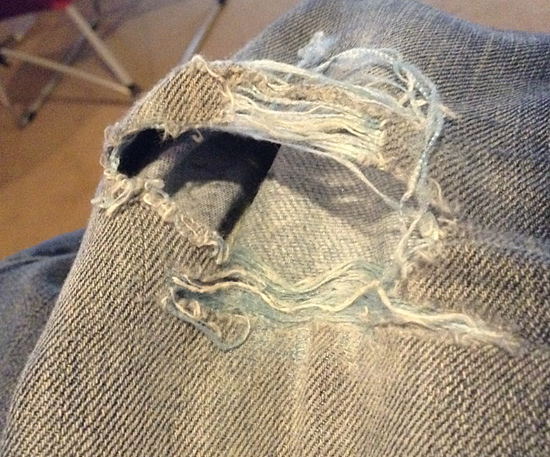
While I could put patches over these ripped knees, I also don’t want my kids to be self-conscious of an obvious repair job. Sometimes things simply wear out, and there’s nothing you can do. However, I want to share how I’ve been able to extend the life of my sons’ jeans by patching them invisibly…
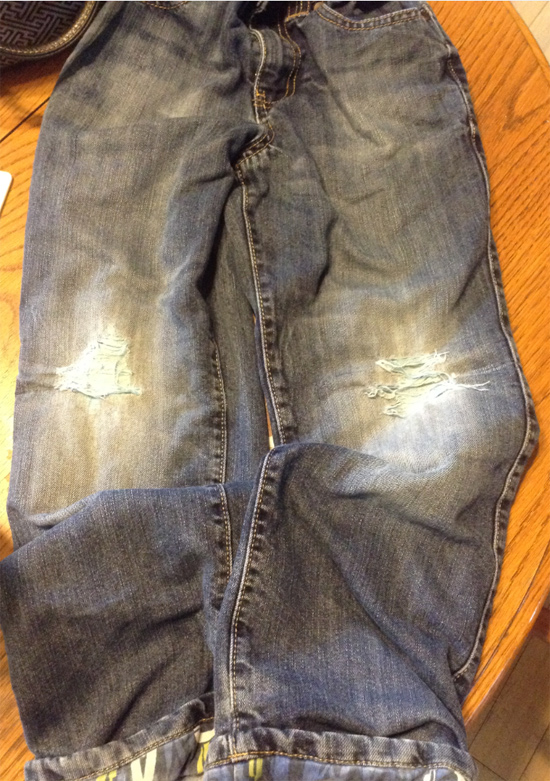
My son has a pair of well-loved flannel lined jeans that he absolutely refuses to get rid of. I get it — they’re broken in to comfy perfection, the flannel lining is warm and soft in cold weather, and they still fit. And, despite the cool factor my kids think ripped jeans have, I don’t like sending them to school with skin sticking out of their knees. My son argued that with this particular pair, his knees weren’t sticking out, because the flannel lining of the jeans was showing through the rips, not his skin. I told him the jeans were fine for at home or for wearing extra layers for outdoor winter play. Then, I stumbled across a clearance sale on these:
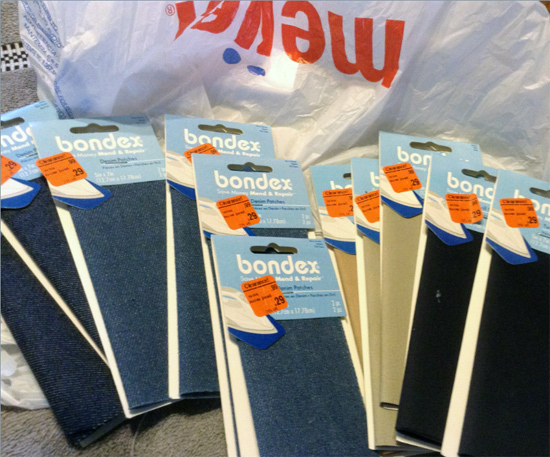
These Bondex iron-on knee repair patches were on clearance at Meijer for .29 each. I thought of my son’s ripped flannel-lined jeans and thought that if I could slip the patches in through the rips, it would bond to them and prevent the knees from ripping further — plus add another layer of fabric for those thin knees. Inspiration struck, and I bought a bunch. I rolled each patch up, inserted it through the holes, then unrolled it with the tacky side facing the front, torn part of the jeans.
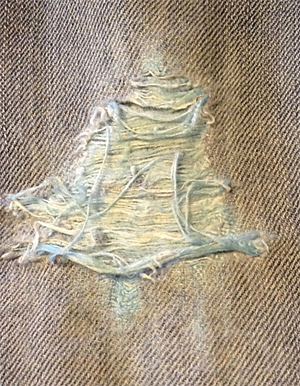
I ironed it on both sides, and now, other than the cosmetic “look” of the rips, the jeans are fine and still being worn. He can still enjoy the warmth of his favorite flannel-lined jeans for another season. I’ve used this method on regular jeans too, though I try to catch them before the knees actually tear. If one of my sons has a pair of jeans that still fit fine but are getting thin, I fix them from the inside.
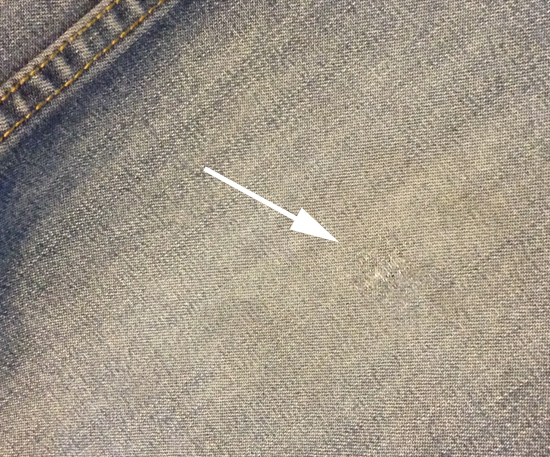
Here’s what I do. I turn the jeans inside out, position the patches over the inside of the knees, then iron them on.
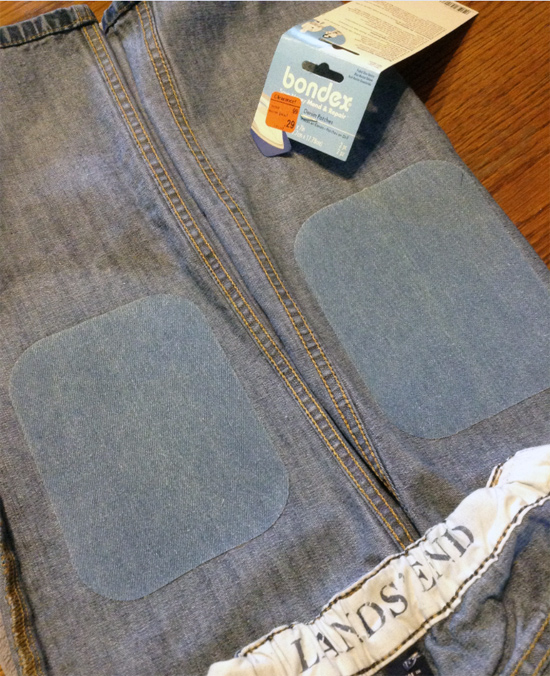
By the way, this is a $5 pair of Land’s End jeans I bought at Sears Outlet a couple years ago! But they still fit my son well, and with the repair, they’ll last a little longer. I’ve used this method to repair a few pairs of jeans and pants now, and I like it because the kids’ jeans don’t look like they’ve been repaired. Even when a knee eventually wears through, it looks like this:
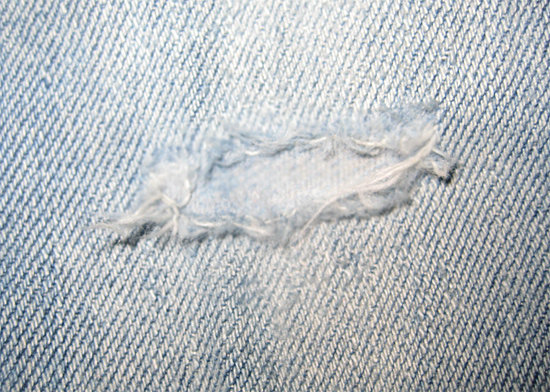
Instead of heading straight to “shredded,” patched knees stay at the “distressed” stage for awhile. The patch’s tacky side helps hold the knees together too.
You might wonder if it would be worth patching the knees from the inside from the point that the jeans are brand new. I haven’t done this for two reasons. One, not all jeans wear out before the boys grow out of them. Even though I picked these patches up on clearance, why use them if it’s really not necessary? Two, I’ve found that once they are patched, washing in hot water and/or putting the patched jeans in the dryer seems to weaken the adhesive of the patch — they’re not entirely permanent. I think high heat makes the tacky side lose some of its stickiness. When this happens, I just re-iron it and it sticks down again. Washing in cool water and drying on low heat helps the patches stay put.
If this seems like something you’d like to try, keep your eyes open for good prices or clearances in the sewing aisle… and don’t be too quick to toss out those worn jeans.










SSMark1 says
Thanks for posting about these patches! I’m going to look for these.
The price of jeans seems to be higher than ever these days. I usually buy at Kohls when the jeans are on sale, with the additional 30% off code, & any other possible discounts if available.
I remember reinforced knees on my jeans when I was a kid in the 70s. My mom bought them that way. They made the knees last much longer. Also, I remember Levi’s when they were still made in the USA vs. Egypt. They also lasted much longer.
I only wash jeans in cold & line dry. This time of year, I string up an electric extension cord as a clothes line in our guest room, and let clothes hang dry in there. My jeans wear out where these patches would extend them for many more days of use. Thanks for this post!
I hate my top loader HE washer. It loves to tie our clothes into knots! But I haven’t had an issue with ripping clothes, except for an old t-shirt which was getting old, it basically fell apart into pieces in the washer.
-Mark
dancingwolves says
my mom used to use them for all kinds of things including rips in the slip covers on furniture.
they last a long time.
jilldianne says
Thanks for the helpful tips! I’ll be sure to look for that in Meijer. I think 3 out of 4 pairs of my son’s jeans have holes in them right now. They usually end up being summer cut-offs, but if I can mend them and make them last through the winter even better. One thing my husband taught him was to wear flannel pj pants under his jeans. This is the same idea as the lined jeans. It’s a little more of a pain when putting the jeans on over the pants, but worth it as he stays toasty warm in the cold.
uasklisa says
I do this all the time! They also sell patches and strips at the fabric stores and walmart. Works with shirts too- especially if you have boys that are hard on them.
You can also easily make your own ‘patches’ for other fabrics or if it’s a weird color that you need to blend in. Buy a piece of heatbond and a fabric to match Cut to fit and iron together!
Thanks Jill…I need to go to Meijer now and see if mine has some patches. With 2 boys I always have a use for them!
moshop says
when washing jeans with patches do not use fabric softener, it makes the patches peel off, instead use some vinegar. Does the same thing but won’t peel the patch
Mrs. C says
I have used the “inside” patch for years to extend the life of my boys’ jeans. Also, I wanted to mention that if you live near a Boy Scout store, they have jeans for $4.66. I noticed them on the table outside the Rockford Scout shop. They only had sizes 4 & 6, but I’ve purchased them for my boys in the past and they hold up well.
LilBlossom says
My 4.5 year old Whirlpool front loader is about to kick the bucket. The bearing is giving up. And the pump has had issues for years. It’ll be a $800 repair for the bearing alone. On a $650 washing machine. The thing is, I’m from Europe, and front loaders there are the norm. And they are so much better quality than over here in the US. Especially Whirlpool. The repairman recommended getting another Whirlpool machine, even with my bad experience. He said they normally last 12 years, not 4.5. We’ll see. His other suggestion was LG.